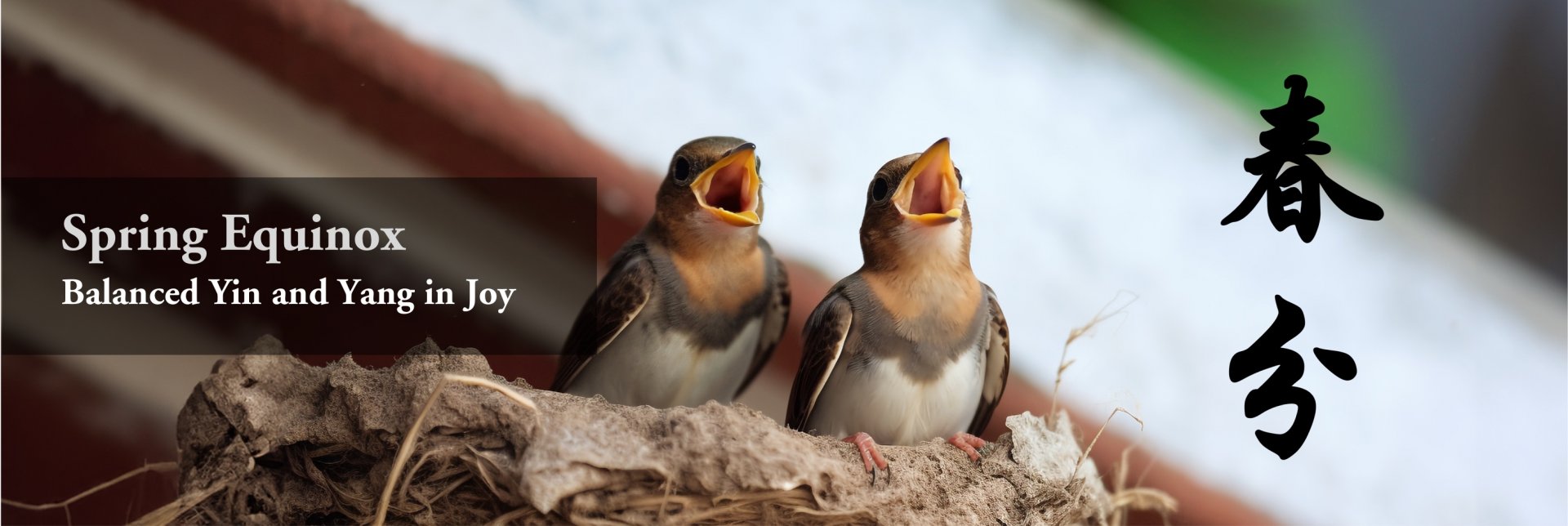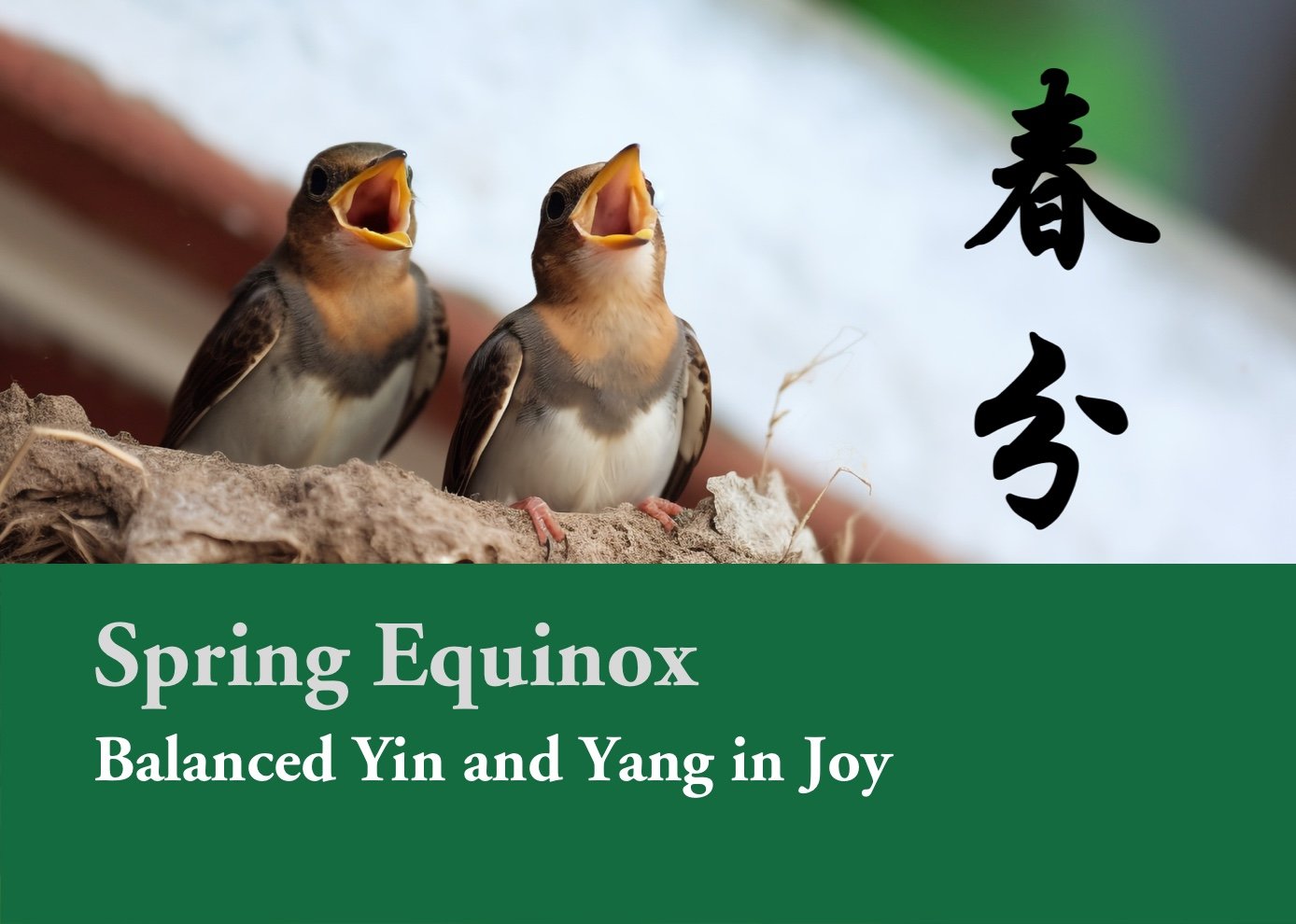Spring Equinox: Balanced Yin and Yang in Joy
Equality is given great attention to in traditional Chinese culture. In Annotations to I-Ching, it’s advocated to act according to timing. Confucius thought overdoing is no better than underdoing. Both of them emphasized opportune behaviors. To be broad, such an ideology can also be understood as “seasonal”. Ever since ancient times, Lantern Festival (the 15th day of the first lunar month) and Mid-Autumn Festival (the 15th day of the eighth lunar month) have been highly valued. Maybe one of the reasons is that these festivals fall on the middle of a lunar month. The four solar terms, i.e. Spring Equinox, Summer Solstice, Autumn Equinox and Winter Solstice, are respectively the middle of the four seasons, which also deserves our attention.
Spring consists of Meng Spring (the first month in spring), Zhong Spring (the second month in spring) and Ji Spring (the third month in spring). Spring Equinox is the middle of the three months, dividing spring equally. The word Equinox basically means “in the middle”. In Interpretation of 72 Hous, Wu Cheng stated that “The middle of the 90 days is called Equinox.” Equinox also means the divide between day and night. That is to say, on Spring Equinox, day and night are equally long, each lasting for 12 hours. So Dong Zhongshu wrote in Annotations to the Spring and Autumn Annals that “(On Spring Equinox,) day and night are equally divided while coldness and heat are balanced.” From the aspect of modern astronomy, Spring Equinox is the day when the sun is straight over the equator, leaving day and night in the southern and northern hemispheres equal in duration, except the south and north poles.

The seasonal equality in the solar term is one of the favorite themes of poets and artists. Liu Zhangqing in Tang dynasty wrote in his poem Spring Equinox that “The sun and the moon are balanced, so are Yin and Yang.” In a series of poems on the 24 solar terms, Yuan Zhen emphasized that “Spring Equinox is the middle of the second lunar month” and “Equinox divides spring in half”. Since Song dynasty, the development of journal poetry produced more season-themed works, including the poems eulogizing Spring Equinox. For example, Xu Xuan in the Northern Song dynasty wrote in Spring Equinox that “Spring is equally divided by the 4th day of the second lunar month.” Notably, the materials in Spring Cultivation Picture by Yu Zhiding, a renowned artist in Qing dynasty, relate essentially to the custom of delivering Spring Ox Pictures on Spring Equinox. Hence such elements as farmers calling oxen and cultivation are kept in the long scroll. Of course, Yu’s Spring Cultivation Picture differs from the folk Spring Ox Pictures in two major aspects. First, the figure of a government official is added to demonstrate the local officials’ concern about people and appeal for agricultural cultivation. Second, the painting is artistically arranged, dividing the plane into two symmetric parts with a diagonal, i.e. a river flows from the upper left to the lower right, with a small bridge linking them in the middle. The artist expressed equality with a diagonal ingeniously, integrating balance into the dynamic scene. Some regard the work as more than a mere scene of spring cultivation, but also one with the connotation of Spring Equinox. That makes sense.

In terms of customs, there is a popular game on Spring Equinox called Stand Up, i.e. to erect eggs. Now we are well aware that it’s hard to erect eggs. However, the ancients considered Spring Equinox a day when day and night are equal in duration, during which Yin and Yang are balanced, so it’s possible to erect eggs on a plane. As a popular saying goes, “Eggs look nice when Spring Equinox comes.” Liu Zhangqing also mentioned in his poem Spring Equinox that “It has been a tradition to erect Jizi on this day.” Therein Jizi refer to eggs. Being simple, fun, full of wisdom and traditional cultural implication, the custom of erecting eggs on Spring Equinox has caught the attention of modern creative culture designers who plan to develop a series of creative cultural products. With the growing impact of traditional Chinese culture, the 24 solar terms have been included in the Intangible Cultural Heritage List by UNESCO, and the custom of erecting eggs on Spring Equinox gradually spreads in the global village as a worldwide game.

During this period, the return of swallows and flying kites make people feel warm. Swallows are migrant birds. According to the ancients, they come on Spring Equinox and leave on Autumn Equinox. The first climatic phenomenon during Spring Equinox is the arrival of swallows, namely the swallows return to nest on beams and bring a sense of warmth and auspice. As Tao Yuanming wrote, “The new swallows fly into my room in pair” like the return of old acquaintances, a cordial line indeed. When a nestle of baby swallows are born, people would feel all the more cheerfully harmonious. As for flying kites, it’s one of the significant folk customs. The aforementioned poem Spring Equinox by Liu Zhangqing describes the scene where quite a few people fly kites on the riverside meadow when swallows return. Flying kites in spring is also a favorite theme of Mr. Feng Zikai, a celebrated modern artist who made numerous works with graceful imagery. When seeing these paintings on a sunny spring day over a cup of mellow tea, even readers who lack the experience of flying kites can’t help admiring it, mind fluttering with the kite in a burst of harmonious pleasure. Though the timing of flying kites varies from place to place due to geographical, climatic and other factors, flying kites on a pleasant spring day is unanimously to free our mood, blessed with the best wishes for prosperity.

Reference:
Journal Article
1. 楊子玉:〈春分文化元素在文創產品中的娛樂互動性研究〉,《美術與設計》,第9期(2022年)。
2. 錢國宏:〈春分習俗趣談〉,《內蒙古林業》,第4期(2022年)。
News or Magazine Article
1. 秦延安:〈〈春耕草堂圖〉的春分深味〉,《中國社會科學報》,2022年4月27 日第9版。
All articles/videos are prohibited from reproducing without the permission of the copyright holder.




Welcome to leave a message:
Please Sign In/Sign Up as a member and leave a message正是宋歐陽修《踏莎行》:
雨霽風光,春分天氣。
千花百卉爭明媚,畫梁新燕一雙雙....。
#1
Chi Seng Pun
22-03-2023 09:27:05